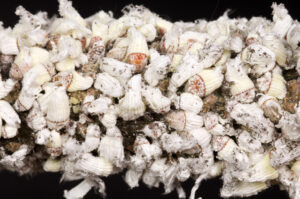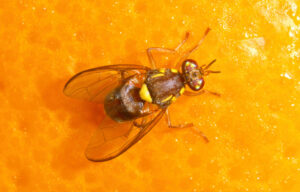Alternatives to pesticides
By Denis Crawford
Given the recent debate in the media about the future of pesticides in some parts of the world, it’s time to look at the alternatives to pesticides.
A recent series of articles in The Guardian“Toxic nation: Australia’s pesticide problem” highlighted several issues with pesticide use in Australia. The series looked at important issues including the role of the regulator APVMA (Australian Pesticide and Veterinary Medicines Authority), pesticide use here compared to other parts of the world, pesticide residues in food, and the environmental impact of fertiliser and pesticide runoff from intensive farming. Lobby groups for and against the use of pesticides joined the fray and the argy-bargy began. I recommend you search for the articles online for the details.
One Guardian article published at the time really stuck out for me “There are real alternatives to widespread pesticide use. Australia must embrace the change.” by Sarina Macfadyen and Nancy Schellhorn. I couldn’t agree more. FYI Dr Sarina Macfadyen is a senior research scientist and agroecology team leader at CSIRO (Commonwealth Scientific and Industrial Research Organisation), and Dr Nancy Schellhorn is the co-founder and CEO of RapidAIM bio-digital crop protection.
The article highlighted biopesticides as an alternative to synthetic pesticides. An obvious example for horticulturists is Dipel® which is based on the bacteria Bacillus thuringiensis (Bt) and specific to caterpillars. The bacteria must be consumed by the caterpillar, which means the product takes longer to work compared to contact insecticides, which kill caterpillars almost immediately.

(Supplied by Denis Crawford of Graphic Science)
With Bt, the best option is to keep an eye on moths laying eggs, watch for the eggs to hatch and then apply Bt. The formulation works more efficiently on small larvae rather than mature larvae. Crops need to be monitored regularly for this to work. Another well-known biopesticide is Green Guard®, a product based on the fungus Metarhizium anisopliae var. acridum, used to control wingless grasshoppers and Australian plague locust.
Despite these targeted biopesticides being available, there is still an awful lot of synthetic pesticides used in Australia. The CSIRO says “Despite opportunities and some success via Integrated Pest/Weed/Disease Management (IPM), there continues to be an over-reliance on chemicals throughout much of agriculture.” Their own figures show that in Australia, the use of agricultural chemicals (e.g., insecticides, miticides, herbicides, fungicides) has doubled since 1992 to over 50,000 tonnes each year, costing around $3.7 billion. As they say, “To support resilience in pest, weed and disease control and address social license concerns, there is a clear case to modify how chemicals are used in the coming years.”
It’s important to remember that IPM was developed during the 1960s in response to increased resistance to pesticides. Insect pests such as green peach aphid (Myzus persicae) and corn earworm (Helicoverpa armigera) had become resistant to most of the insecticides registered against them. The answer was a system that used pesticides as a last resort rather than a first resort, so ‘modifying how chemicals are used’ is not a new thing.
Along with IPM, some novel approaches were developed to reduce growers’ reliance on insecticides. Take fruit fly for example. Controlling Queensland fruit fly (Bactrocera tryoni) and Mediterranean fruit fly (Ceratitis capitata) has always been a major headache for Australian fruit producers. The Sterile Insect Technique (SIT) has proven to be a very useful fruit fly management tool. SIT involves the breeding and release of millions of sterile insects into the wild population to significantly reduce fruit fly reproduction.
SIT is not a new technique. SIT for Queensland fruit fly was first trialled in New South Wales in the 1960s, and the first use of SIT in Western Australia for Mediterranean fruit fly (Medfly) began in 1978. SIT is now used in combination with pheromone lure traps and bait spotting. In other words, classic IPM.

(Supplied by Denis Crawford of Graphic Science)
There are some new fruit fly traps that are more sophisticated than passive pheromone traps. A trap developed by RapidAim was featured in an ABC Landline (June 12, 2022) story on fruit fly control. I recommend you check it out. The battery-powered traps can identify an insect as a fruit fly, send a signal to the cloud and the information is fed back to the farmer in real time. If several traps are deployed throughout a crop, a grower can map where the pest is present, and management can be carefully targeted in a timely manner. The older pheromone traps work in a similar manner, but the information transfer is much slower – a day or two is not uncommon – and more staff are required. The next generation of these traps will attract an insect, identify it, treat it with a biopesticide (e.g., fungal) and release the insect to spread the spores among the rest of the population.
Let’s not forget biological control i.e., predators and parasites. A reduction in pesticide use will usually result in an increase of all kinds of insects in a crop, and some of those insects will be predators and parasites of pest insects that may affect that crop. Biological control has been around for a long time. Sure, there have been some disasters – cane toads anyone? Equally, there have been some major success stories such as the control of prickly pear in the 1920s. A classic successful insect story dates all the way back to 1888 when the vedalia beetle (Rodolia cardinalis), an Australian ladybird beetle, was introduced into California in 1888. The beetle was released as a biological control agent for cottony cushion scale (Icerya purchasi) which had devastated the Californian citrus industry.
If alternatives to pesticides have been around for a while, but the use of pesticides has increased, what is going on? As The Captain said in Cool Hand Luke, “What we have here is a failure to communicate”. CSIRO has been leading a discussion with agricultural industries, government departments, financial services, processors, exporters, retailers and consumers over the last couple of years to address what it calls the Agripest Challenge. It says, “to achieve change will require more than science research, but a strengthened process for the co-innovation of solutions throughout supply chains”. Importantly, CSIRO found that data sharing is one of the biggest impediments to developing partnerships across the supply chains. I will watch with interest to see if anything changes.
Main photo: Control Helicoverpa larvae with an IPM program (Supplied by Denis Crawford of Graphic Science)

